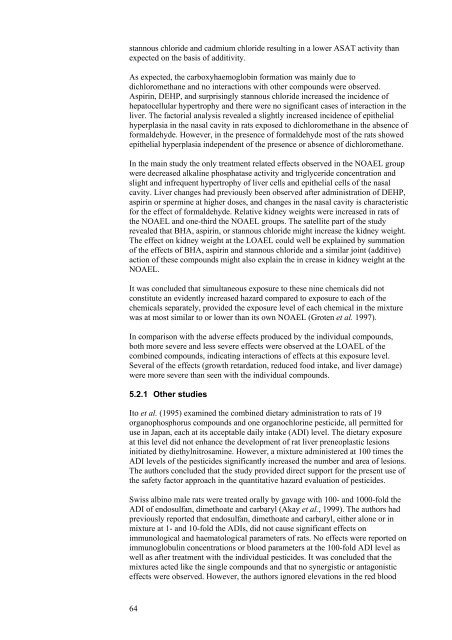Combined Actions and Interactions of Chemicals in Mixtures
Combined Actions and Interactions of Chemicals in Mixtures
Combined Actions and Interactions of Chemicals in Mixtures
You also want an ePaper? Increase the reach of your titles
YUMPU automatically turns print PDFs into web optimized ePapers that Google loves.
stannous chloride <strong>and</strong> cadmium chloride result<strong>in</strong>g <strong>in</strong> a lower ASAT activity than<br />
expected on the basis <strong>of</strong> additivity.<br />
As expected, the carboxyhaemoglob<strong>in</strong> formation was ma<strong>in</strong>ly due to<br />
dichloromethane <strong>and</strong> no <strong>in</strong>teractions with other compounds were observed.<br />
Aspir<strong>in</strong>, DEHP, <strong>and</strong> surpris<strong>in</strong>gly stannous chloride <strong>in</strong>creased the <strong>in</strong>cidence <strong>of</strong><br />
hepatocellular hypertrophy <strong>and</strong> there were no significant cases <strong>of</strong> <strong>in</strong>teraction <strong>in</strong> the<br />
liver. The factorial analysis revealed a slightly <strong>in</strong>creased <strong>in</strong>cidence <strong>of</strong> epithelial<br />
hyperplasia <strong>in</strong> the nasal cavity <strong>in</strong> rats exposed to dichloromethane <strong>in</strong> the absence <strong>of</strong><br />
formaldehyde. However, <strong>in</strong> the presence <strong>of</strong> formaldehyde most <strong>of</strong> the rats showed<br />
epithelial hyperplasia <strong>in</strong>dependent <strong>of</strong> the presence or absence <strong>of</strong> dichloromethane.<br />
In the ma<strong>in</strong> study the only treatment related effects observed <strong>in</strong> the NOAEL group<br />
were decreased alkal<strong>in</strong>e phosphatase activity <strong>and</strong> triglyceride concentration <strong>and</strong><br />
slight <strong>and</strong> <strong>in</strong>frequent hypertrophy <strong>of</strong> liver cells <strong>and</strong> epithelial cells <strong>of</strong> the nasal<br />
cavity. Liver changes had previously been observed after adm<strong>in</strong>istration <strong>of</strong> DEHP,<br />
aspir<strong>in</strong> or sperm<strong>in</strong>e at higher doses, <strong>and</strong> changes <strong>in</strong> the nasal cavity is characteristic<br />
for the effect <strong>of</strong> formaldehyde. Relative kidney weights were <strong>in</strong>creased <strong>in</strong> rats <strong>of</strong><br />
the NOAEL <strong>and</strong> one-third the NOAEL groups. The satellite part <strong>of</strong> the study<br />
revealed that BHA, aspir<strong>in</strong>, or stannous chloride might <strong>in</strong>crease the kidney weight.<br />
The effect on kidney weight at the LOAEL could well be expla<strong>in</strong>ed by summation<br />
<strong>of</strong> the effects <strong>of</strong> BHA, aspir<strong>in</strong> <strong>and</strong> stannous chloride <strong>and</strong> a similar jo<strong>in</strong>t (additive)<br />
action <strong>of</strong> these compounds might also expla<strong>in</strong> the <strong>in</strong> crease <strong>in</strong> kidney weight at the<br />
NOAEL.<br />
It was concluded that simultaneous exposure to these n<strong>in</strong>e chemicals did not<br />
constitute an evidently <strong>in</strong>creased hazard compared to exposure to each <strong>of</strong> the<br />
chemicals separately, provided the exposure level <strong>of</strong> each chemical <strong>in</strong> the mixture<br />
was at most similar to or lower than its own NOAEL (Groten et al. 1997).<br />
In comparison with the adverse effects produced by the <strong>in</strong>dividual compounds,<br />
both more severe <strong>and</strong> less severe effects were observed at the LOAEL <strong>of</strong> the<br />
comb<strong>in</strong>ed compounds, <strong>in</strong>dicat<strong>in</strong>g <strong>in</strong>teractions <strong>of</strong> effects at this exposure level.<br />
Several <strong>of</strong> the effects (growth retardation, reduced food <strong>in</strong>take, <strong>and</strong> liver damage)<br />
were more severe than seen with the <strong>in</strong>dividual compounds.<br />
5.2.1 Other studies<br />
Ito et al. (1995) exam<strong>in</strong>ed the comb<strong>in</strong>ed dietary adm<strong>in</strong>istration to rats <strong>of</strong> 19<br />
organophosphorus compounds <strong>and</strong> one organochlor<strong>in</strong>e pesticide, all permitted for<br />
use <strong>in</strong> Japan, each at its acceptable daily <strong>in</strong>take (ADI) level. The dietary exposure<br />
at this level did not enhance the development <strong>of</strong> rat liver preneoplastic lesions<br />
<strong>in</strong>itiated by diethylnitrosam<strong>in</strong>e. However, a mixture adm<strong>in</strong>istered at 100 times the<br />
ADI levels <strong>of</strong> the pesticides significantly <strong>in</strong>creased the number <strong>and</strong> area <strong>of</strong> lesions.<br />
The authors concluded that the study provided direct support for the present use <strong>of</strong><br />
the safety factor approach <strong>in</strong> the quantitative hazard evaluation <strong>of</strong> pesticides.<br />
Swiss alb<strong>in</strong>o male rats were treated orally by gavage with 100- <strong>and</strong> 1000-fold the<br />
ADI <strong>of</strong> endosulfan, dimethoate <strong>and</strong> carbaryl (Akay et al., 1999). The authors had<br />
previously reported that endosulfan, dimethoate <strong>and</strong> carbaryl, either alone or <strong>in</strong><br />
mixture at 1- <strong>and</strong> 10-fold the ADIs, did not cause significant effects on<br />
immunological <strong>and</strong> haematological parameters <strong>of</strong> rats. No effects were reported on<br />
immunoglobul<strong>in</strong> concentrations or blood parameters at the 100-fold ADI level as<br />
well as after treatment with the <strong>in</strong>dividual pesticides. It was concluded that the<br />
mixtures acted like the s<strong>in</strong>gle compounds <strong>and</strong> that no synergistic or antagonistic<br />
effects were observed. However, the authors ignored elevations <strong>in</strong> the red blood<br />
64

















